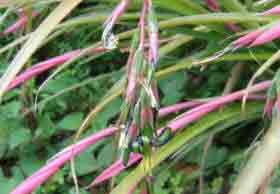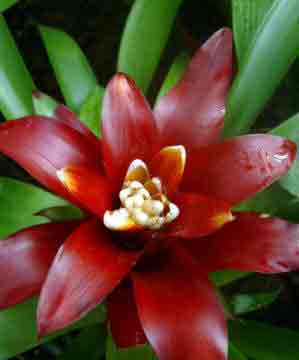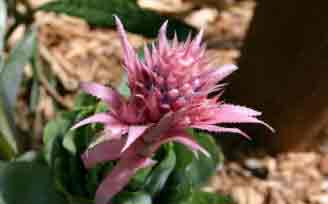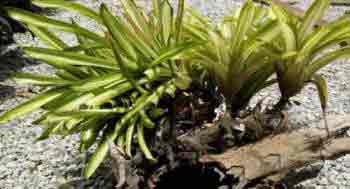
Whilst it can be easily understood how they can get their moisture
requirement in the humid enclosure of rain forests, one can only wonder
at their storage mechanisms for those that live in semi-desert areas as
terrestrial plants Cryptanthus being typical. The Pineapple a
terrestrial bromeliad - has been adopted for commercial growing in SE
Asia, and is subject to the varied climatic conditions which often
includes weeks of no rain in baking temperatures of 35 deg or more.
Foliage of Bromeliads
The leaves invariably form a whirl of leathery straps, either blunted
or pointed at the ends. Some are serrated viciously so, as with the
pineapple whilst others are smooth. The foliage is an attractive
aspect, and will in any event last much longer than the flowers.
The whorl of foliage emanates from the base, overlapping tightly to
form a virtual waterproof urn in many instances. Leaves can vary in
colours from silvery grey, through to many shades os pink and orange,
with some even being a fiery red.

Flowers of Bromeliads
The flowers of bromeliads are often quite spectacular with shades of
yellow, pink and crimson often bi-coloured. Some of the family group
are noted for their central crown of flowers deep down in the urn,
whilst others radiate from the centre on long stalks erupting in some of
the gaudiest displays seen in the plant kingdom.
Unfortunately, the flowers herald the demise of the plant, for they
only flower once in their lifetime from the same urn. However, before
this, then ensure that life continues, by sending out offshoots from the
base of the plant which are affectionately known as Bromeliad Pups.
As can be seen in the images below, all of the Bromeliad flowers are
quite spectacular - almost artificial - though not all are happy to
extend from the comfort of their central urn!
Care of Bromeliads
The care regime for bromeliads depends entirely as to the individual
types and their original habitat. Terrestrial types invariably need dry
conditions, though will tolerate humidity. Good light is essential
even bright sunlight. Many can be grown outdoors during the summer
months and make spectacular patio features!
The rainforest types will require high humidity, and good organic
compost when grown as pot plants and generally need more care than the
terrestrial types. Acid composts are necessary, and
watering
should be carried out either with distilled water, rain water and tap
water only if from a non-alkaline area.

Feeding Bromeliads
The rainforest bromeliads will be happiest if fed a liquid feed
throughout the growing period of summer. The feed should be weak and
regular. Every two weeks seems to be satisfactory care, and
should be watered into the compost. Where grown attached to an old trunk
or moss pole, foliage feeding is good.
Propagation of Bromeliads
The plant in the image above, has never flowered, but has sent out
many offshoots which can easily be cut off the parent plant. Normally,
after flowering, the central whorl of the main plant will die off but
you will be provided with offsets (Pups) which can easily be propagated
to form new plants.
Simply place the offshoot into a small pot of well draining compost
which will simply have to be kept moist. The Pup offshoot will soon root
into the soil, and can either be grown o0n as a pot plant or
transferred to the crotch of an attractive log, or wired to a suitable
host wood seems to be the best, though moist moss sticks suit as well.
Comprehensive Guide to Propagate Bromeliads
Basic Facts About Bromeliads
Bromeliads are an incredibly diverse family of plants native to tropical and subtropical regions. They come in a wide range of sizes, colors, and shapes, including popular varieties like Pineapple (Ananas comosus), Air Plant (Tillandsia), and Queen's Tears (Billbergia nutans).
Bromeliads are known for their striking foliage and dramatic flowers. They are typically epiphytic, meaning they grow on other plants or structures for support instead of in the soil, but some species are terrestrial. They prefer bright, indirect light, well-draining substrate, and high humidity.
Materials Needed for Propagation
-
A mature bromeliad plant with pups (offsets)
-
A sharp, clean knife or pruners
-
A pot with drainage holes
-
Bromeliad or orchid mix, or a DIY mix of equal parts perlite, coarse sand, and peat moss
-
Rooting hormone (optional)
Propagation Steps
-
Step 1: Select a Healthy Bromeliad
Choose a mature bromeliad that has produced pups. Pups are the small plants that grow from the base of the mother plant. They should be one-third to half the size of the mother plant before they are removed for propagation.
-
Step 2: Remove the Pup
Using a sharp, clean knife or pruners, cut the pup away from the mother plant. Try to include some roots if possible. If the pup is tightly attached, you may need to remove some of the mother plant's lower leaves for better access.
-
Step 3: Let the Cut Dry
Allow the cut on the pup to dry for a day or two before planting. This helps prevent rot.
-
Step 4: Plant the Pup
Fill a pot with your chosen planting medium and make a hole in the center. Place the pup in the hole, ensuring that the base where it was cut is level with the surface of the soil. Firm the soil around the pup to keep it upright.
-
Step 5: Water and Care for Your New Plant
Water the soil lightly, keeping it barely moist until new growth indicates that the pup has rooted. Place the pot in a location with bright, indirect light and high humidity.
Post-Propagation Care
Once the pup has taken root and started growing, care for it as you would any bromeliad. Water the central cup of the plant, allowing the water to overflow into the soil. Allow the soil to dry out before watering again. Fertilize sparingly during the growing season with a balanced, water-soluble fertilizer diluted to half strength.
Potential Challenges and Solutions
Challenge: The pup wilts or turns brown after planting.
Solution: This could be a sign of overwatering or rot. Make sure the soil is well-draining and only barely moist. If rot is suspected, remove the pup, cut away any rotten parts, let the cut dry, and replant in fresh, dry soil.
Challenge: The pup isn't growing.
Solution: Be patient. Bromeliads are slow growers, and it can take a few months for pups to establish their roots and begin growing. Ensure the plant is receiving appropriate light and humidity.
With patience and care, propagating bromeliads can be a rewarding experience. Enjoy watching your new plants grow and flourish!
Problems with Bromeliads
The normal range of houseplant pests can be anticipated and should be
searched out regularly. These include
red spider mite,
mealybugs and of
course aphids. Scale is rarely a problem, though should not be
discounted.
Bromeliads rarely suffer from any fungal disease. If it is present,
it normally signifies that there is a basic problem with the plant.
Fungal diseases are not normally the cause of any demise.
Types of Bromeliads suitable as House Plants
- Cryptanthus - Terrestrial
Bromeliads which are normally found in dry forests, growing in the
soil or rocky slopes. They are known as Earth Star or Starfish
plants because of the rosette of low foliage.
- Neorogelia As seen in the opening image a top, normally spread
by rhizomes, are can either be epiphytic or terrestrial. Flowers are
sunk into the typical bromeliad urn.
- Aechmea Large whorls of
rosette foliage in wide range of options. Normally epiphytic though
some are terrestrial. Rainforest is the normal habitat.
- Vriesea These are typified with spectacular, large foliage
clumps, and protruding, showy flowers. Can either be terrestrial or
tree huggers. One of which claims the name of King of the
Bromeliads. Can form a small shrub.
- Guzmania Pointed foliage
is typical with spectacular flowers held aloft. Essentially a
rainforest inhabitant normally epiphytic.
- Tillandsia The cute air plants which include the mossy
specimen known as Spanish Moss. Totally epiphytic, and happy on
rocks or dry tree stumps and branches. The trailing moss type best
being anchored wherever it can form a waterfall of silver foliage.
- Nidularium The Birds Nest Bromeliad aptly describes its habit
of growth. Not too far distant in appearance from the Neorogelia.
- Billbergia These can be
either epiphytic of terrestrial types (living on rocky ground) with
long flower stems with the drooping flower heads being an
identifying feature.












